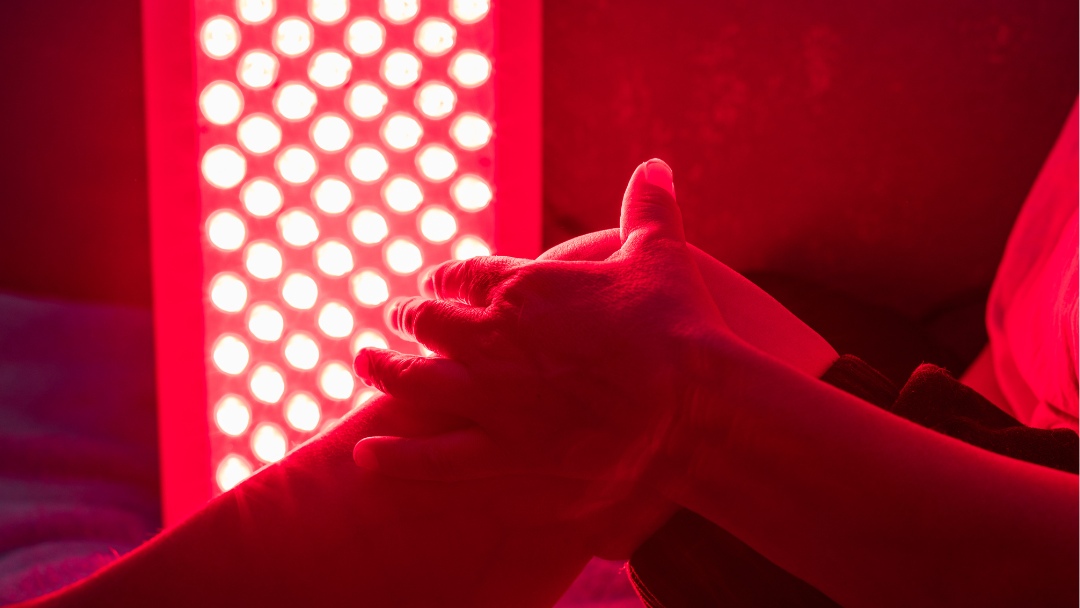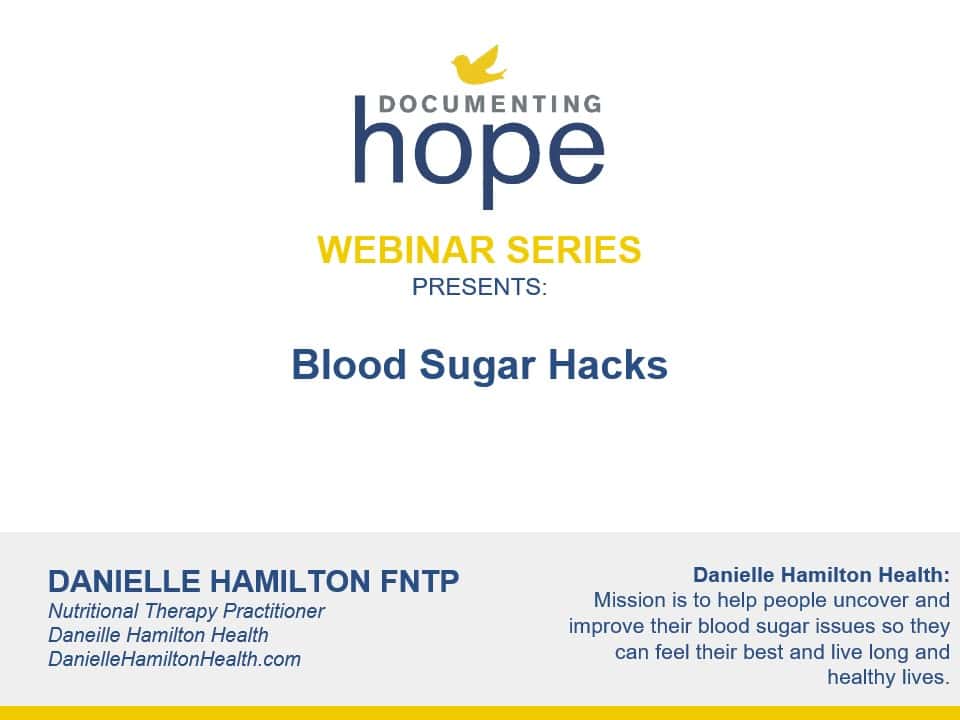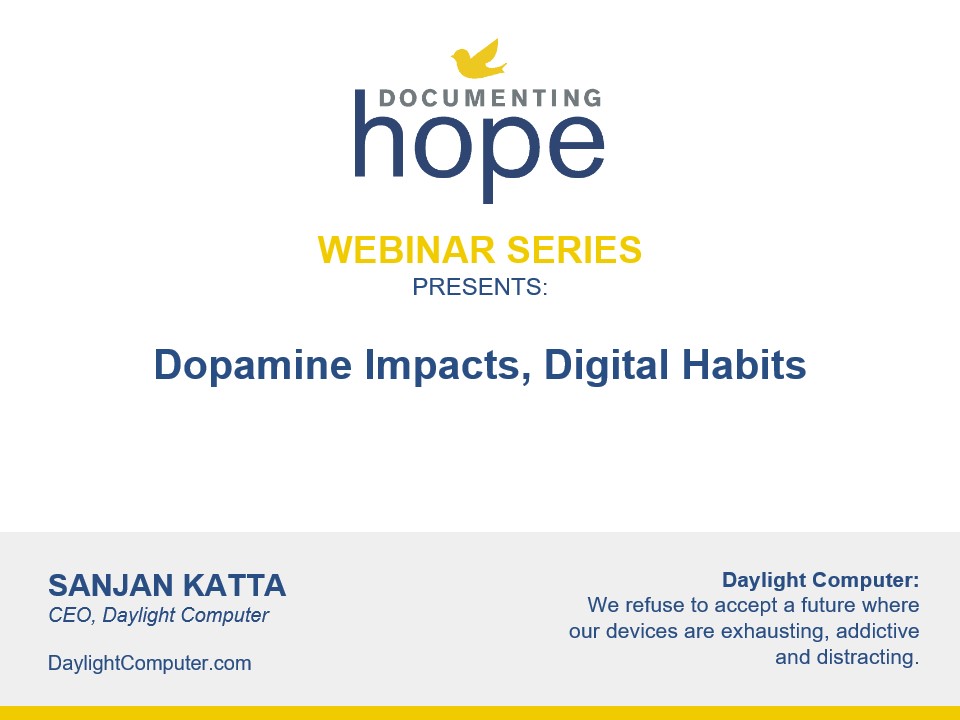Blue light from screens and devices can raise blood sugar and cortisol, while red-light therapy can lower them. Read on to find out why and what you can do.
Effects of Blue Light on Blood Sugar
Sunlight contains the most amount of blue light early in the morning, and the reception of it by the pineal gland in the brain tells the body to wake up and start producing cortisol. In a person whose circadian rhythm is in sync with natural rhythms, cortisol is highest in the morning and then slowly tapers off throughout the day, unless there is unregulated stress, free-floating anxiety or chronic inflammation that cause it to remain high. If cortisol is higher than it should be later in the day or in the evening, it will likely be difficult for such a person to fall asleep or to sleep well.
High cortisol levels can raise blood sugar, and blue light from screens and devices has been documented to raise blood sugar (see Sources & References, below). In the U.S. where 93% of the population is metabolically unhealthy, blue light from screens, LED and fluorescent lights may be contributing to the problem, especially with nighttime exposure.
Effects of Red Light on Blood Sugar
To counteract the effects of artificial blue light, red-light therapy has been shown to lower blood sugar (see Sources & References, below). In this particular study, red light of 670nm (nanometers) was shone on a subject’s back for just 15 minutes, and this was enough to lower test subjects’ average blood sugar by 28%. Researchers theorized that this particular wavelength stimulated energy production within mitochondria, which lead to increased consumption of glucose. This non-invasive therapy may have the potential to impact blood-sugar and insulin control in a non-pharmacological manner.
Putting It All Together
Research continues to bear out the fact that following natural circadian rhythms is best for human health. Most people don’t want to live off the grid or become a Luddite, so here are some practical ways for you and your family to peacefully coexist with technological innovations that may be harming health and raising blood sugar:
- Get as much bright morning light in the early morning as possible. This helps to reset one’s circadian rhythm and is also great advice for jet lag. Bonus points for putting bare feet onto wet grass or sand.
- Get as much natural light as possible throughout the day without getting sunburned. It’s not enough to sit by a window; the window must be open to let in natural light (plus, you’ll get fresh air).
- Avoid wearing sunglasses or blue-blocking glasses in the day, unless you’re looking at a computer, smartphone or other screen. The wavelengths of natural, full-spectrum sunlight signal circadian-based reactions such as hormone production. Blocking the sun’s rays can potentially impact the body’s systems.
- Use blue-light blocking apps like Iris or computers like Daylight Computers. These can automatically adjust the blue- and red-light dimensions of your screen throughout the day. (You can find out more about Daylight here: https://buy.daylightcomputer.com/HOPE, and use the code HOPE to get a $50 discount. Your purchase also benefits Documenting Hope.)
- Use blue-light blocking glasses after dark. These generally have red-tinted lenses.
- Turn off overhead lights after dark. Use low-wattage bulbs for sidelamps. If you’re really brave, replace bulbs with red bulbs or use candles.
- If you have an iPhone, do a custom keybind to make your screen appear amber using Daniel White’s How to Hack Your Smartphone, PC & Laptop for Better Sleep. You can learn more tips in Daniel’s Top Tips for Better Sleep and Circadian Health webinar with us. (Personal note: I did this for my own iPhone and no longer have dry eyes.)
- Get a red-light therapy setup for home use. Peter Sullivan spoke about low-/no-EMF versions of these in his The Role of EMFs in Excitotoxicity, Autism and Seizures webinar with us. Scroll down on the page to the section on Resources Mentioned in This Webinar.
- For more tips on regulating blood sugar in general, view Dani Hamilton’s Blood Sugar Hacks webinar with us, read our Optimizing Blood Sugar article and read our review of The Glucose Goddess’ Glucose Revolution book.
About Maria Rickert Hong CHHC
Maria Rickert Hong is a Co-Founder of, and the Education and Media Director for, Documenting Hope.
She is a former sell-side Wall Street equity research analyst who covered the oil services sector at Salomon Smith Barney and Lehman Brothers under Institutional Investor #1 ranked analysts.
Later, she covered the gaming, lodging & leisure sector at Jefferies & Co. and Calyon Securities. She quit working on Wall Street when her first son was born.

Prior to working on Wall Street, she was a marketing specialist for Halliburton in New Orleans, where she also received her MBA in Finance & Strategy from Tulane University.
She is the author of the bestselling book Almost Autism: Recovering Children from Sensory Processing Disorder and the co-author of Brain Under Attack: A Resource for Parents and Caregivers of Children with PANS, PANDAS, and Autoimmune Encephalitis. She is a co-author of Reversal of Autism Symptoms among Dizygotic Twins through a Personalized Lifestyle and Environmental Modification Approach: A Case Report and Review of the Literature, J. Pers. Med. 2024, 14(6), 641.
Maria is also a Certified Holistic Health Counselor. Her work can be found on DocumentingHope.com, Healing.DocumentingHope.com, Conference.DocumentingHope.com and MariaRickertHong.com
Still Looking for Answers?
Visit the Documenting Hope Practitioner Directory to find a practitioner near you.
Join us inside our online membership community for parents, Healing Together, where you’ll find even more healing resources, expert guidance, and a community to support you every step of your child’s healing journey.
Sources & References
Alam, M., et al. Impacts of Blue Light Exposure From Electronic Devices on Circadian Rhythm and Sleep Disruption in Adolescent and Young Adult Students. Chronobiology in Medicine. 2024;6(1):10-14.
Baek, J.H., et al. Artificial Light at Night and Type 2 Diabetes Mellitus. Diabetes Metab J. 2024 Sep;48(5):847-863.
Bondopadhyay, U., et al. The Role of the Circadian System in Attention Deficit Hyperactivity Disorder. Adv Exp Med Biol. 2021:1344:113-127.
Cain, S.W., et al. Evening home lighting adversely impacts the circadian system and sleep. Sci Rep. 2020 Nov 5;10(1):19110.
Carpena-Torres, C., et al. Increased ocular dopamine levels in rabbits after blue light stimulation of the optic nerve head. Exp Eye Res. 2023 Sep:234:109604.
Chang, Y., et al. Mechanism of Sleep Disturbance in Children with Atopic Dermatitis and the Role of the Circadian Rhythm and Melatonin. Int J Mol Sci. 2016 Mar 29;17(4):462.
Cheung, I.N., et al. Morning and Evening Blue-Enriched Light Exposure Alters Metabolic Function in Normal Weight Adults. PLoS One. 2016 May 18;11(5):e0155601.
Dauchy, R.T., et al. Daytime Blue Light Enhances the Nighttime Circadian Melatonin Inhibition of Human Prostate Cancer Growth. Comp Med. 2015 Dec;65(6):473-85.
Esaki, Y., et al. Wearing blue light-blocking glasses in the evening advances circadian rhythms in the patients with delayed sleep phase disorder: An open-label trial. Chronobiol Int. 2016;33(8):1037-44.
Fagundo-Rivera, J., et al. Relationship between Night Shifts and Risk of Breast Cancer among Nurses: A Systematic Review. Medicina (Kaunas). 2020 Dec 10;56(12):680.
Fargason, R.E., et al. Correcting delayed circadian phase with bright light therapy predicts improvement in ADHD symptoms: A pilot study. J Psychiatr Res. 2017 Aug:91:105-110.
Fasciani, I., et al. A New Threat to Dopamine Neurons: The Downside of Artificial Light. Neuroscience. 2020 Apr 15:432:216-228.
Figueiro, M.G., et al. Light modulates leptin and ghrelin in sleep-restricted adults. Int J Endocrinol. 2012:2012:530726.
Gabel, V., et al. Effects of artificial dawn and morning blue light on daytime cognitive performance, well-being, cortisol and melatonin levels. Chronobiol Int. 2013 Oct;30(8):988-97.
Gooley, J.J., et al. Exposure to room light before bedtime suppresses melatonin onset and shortens melatonin duration in humans. J Clin Endocrinol Metab. 2011 Mar;96(3):E463-72.
Gringras, P., et al. Bigger, Brighter, Bluer-Better? Current Light-Emitting Devices – Adverse Sleep Properties and Preventative Strategies. Front Public Health. 2015 Oct 13:3:233.
Hartstein, L.E., et al. High sensitivity of melatonin suppression response to evening light in preschool-aged children. J Pineal Res. 2022 Mar;72(2):e12780.
Hester, L., et al. Evening wear of blue-blocking glasses for sleep and mood disorders: a systematic review. Chronobiol Int. 2021 Oct;38(10):1375-1383.
IARC Working Group on the Identification of Carcinogenic Hazards to Humans. Night Shift Work: IARC Monographs on the Identification of Carcinogenic Hazards to Humans Volume 124. International Agency for Research on Cancer, World Health Organization, Lyon (FR), 2020.
Koo, Y.S., et al. Outdoor artificial light at night, obesity, and sleep health: Cross-sectional analysis in the KoGES study. Chronobiol Int. 2016;33(3):301-14.
Lok, R., et al. Perils of the nighttime: Impact of behavioral timing and preference on mental health in 73,888 community-dwelling adults. Psychiatry Res. 2024 May 15:337:115956.
Maggio, R., et al. Parkinson’s disease and light: The bright and the Dark sides. Brain Res Bull. 2019 Aug:150:290-296.
Makateb, A., et al. Investigating the effects of a blue-blocking software on the daily rhythm of sleep, melatonin, cortisol, positive and negative emotions. Chronobiol Int. 2023 Jul 3;40(7):896-902.
Martel, J. Is a return to nature a piece of the health puzzle? Biomed J. 2023 Feb;46(1):8-10. Physiol Rep. 2019 Oct;7(20):e14257.
Masís-Vargas, A., et al. Blue light at night acutely impairs glucose tolerance and increases sugar intake in the diurnal rodent Arvicanthis ansorgei in a sex-dependent manner. Physiol Rep. 2019 Oct;7(20):e14257.
Mason, I.C., et al. Light exposure during sleep impairs cardiometabolic function. Proc Natl Acad Sci U S A. 2022 Mar 22;119(12):e2113290119.
Megha, K.B., et al. Significance of Melatonin in the Regulation of Circadian Rhythms and Disease Management. Mol Neurobiol. 2024 Jan 11.
Nash, T.R., et al. Daily blue-light exposure shortens lifespan and causes brain neurodegeneration in Drosophila. NPJ Aging Mech Dis. 2019 Oct 17:5:8.
O’Hearn,M., et al. Trends and Disparities in Cardiometabolic Health Among U.S. Adults, 1999-2018. J Am Coll Cardiol. 2022 Jul 12;80(2):138-151.
Ondrusova, K., et al. Subcutaneous white adipocytes express a light sensitive signaling pathway mediated via a melanopsin/TRPC channel axis. Sci Rep. 2017 Nov 27;7(1):16332.
Opperhuizen, A.L., et al. Light at night acutely impairs glucose tolerance in a time-, intensity- and wavelength-dependent manner in rats. Diabetologia. 2017 Jul;60(7):1333-1343.
Powner, M.B., et al. Light stimulation of mitochondria reduces blood glucose levels. J Biophotonics. 2024 May;17(5):e202300521.
Powner, M.B., et al. Systemic glucose levels are modulated by specific wavelengths in the solar light spectrum that shift mitochondrial metabolism. PLoS One. 2022 Nov 3;17(11):e0276937.
Randjelović, P., et al. The effect of reducing blue light from smartphone screen on subjective quality of sleep among students. Chronobiol Int. 2023 Mar;40(3):335-342.
Romeo, S., et al. Bright light exposure reduces TH-positive dopamine neurons: implications of light pollution in Parkinson’s disease epidemiology. Sci Rep. 2013:3:1395.
Salomon, I., et al. Artificial light exposure at night: A hidden risk factor for type 2 diabetes. Sleep Med X. 2025 Jun 14:10:100146.
Uğurlu, A.K., et al. Is blue light exposure a cause of precocious puberty in male rats? Front Endocrinol (Lausanne). 2023 Jun 20:14:1190445.
van Andel, W., et al. Effects of chronotherapy on circadian rhythm and ADHD symptoms in adults with attention-deficit/hyperactivity disorder and delayed sleep phase syndrome: a randomized clinical trial. Chronobiol Int. 2021 Feb;38(2):260-269.
Wang, C., et al. The association between blue light exposure and incidence of type 2 diabetes: A prospective study of UK biobank. Environ Res. 2024 Apr 1:246:118070.
Wang, W., et al. Long-term artificial/natural daytime light affects mood, melatonin, corticosterone, and gut microbiota in rats. Appl Microbiol Biotechnol. 2023 Apr;107(7-8):2689-2705.
Xie, F., et al. Association between night shift work and the risk of type 2 diabetes mellitus: a cohort-based meta-analysis. BMC Endocr Disord. 2024 Dec 18;24(1):268.
Yoon, J., et al. Assessing the Feasibility and Efficacy of Pre-Sleep Dim Light Therapy for Adults with Insomnia: A Pilot Study. Medicina (Kaunas). 2024 Apr 14;60(4):632.
Zhong, Z., et al. Administration of blue light in the morning and no blue-ray light in the evening improves the circadian functions of non-24-hour shift workers. Chronobiol Int. 2024 Feb;41(2):267-282.







